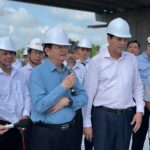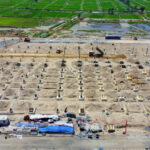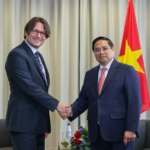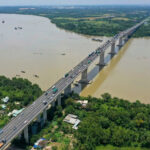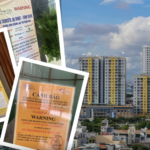Anticipation and Challenges for Ho Chi Minh City’s Metro Line 2
In Ho Chi Minh City, the much-anticipated Metro Line 2 (Ben Thanh – Tham Luong) project spans over 11 kilometers through districts 1, 3, 10, 12, Tan Binh, and Tan Phu. These densely populated areas experience significant infrastructure pressure, and the project is expected to not only alleviate traffic congestion but also boost economic and social development.
Eager Anticipation
On June 6, at Cach Mang Thang Tam Street in District 3, where the S2 Tao Dan station of Metro Line 2 is planned to be constructed, the site was almost entirely cleared. Deep pits that once marked the construction area have been securely filled, eagerly awaiting the commencement of construction.
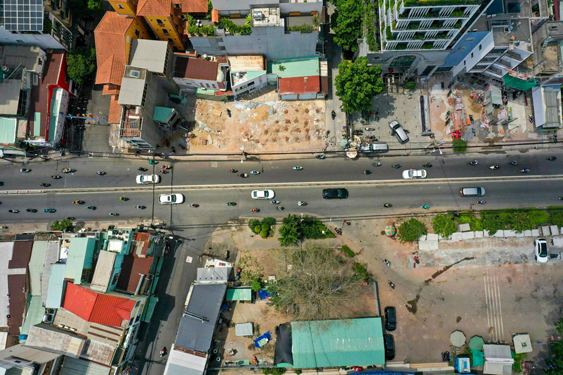
The Metro Line 2 site is ready and awaiting positive signals regarding procedures. Photo: HOANG TRIEU
Mr. Pham Hoang Thai, a local resident, observed a vibrant construction atmosphere in the past. While multiple units rushed to clear, fill, and relocate infrastructure, some tasks, such as power poles, signal lights, and signage, remain unfinished.
“The people of Ho Chi Minh City eagerly await the timely commencement of the metro line to alleviate congestion in a vast area of the city,” said Mr. Thai.
Many young people share this anticipation for the new metro line. Nguyen Tu Tai, a student at Ho Chi Minh City University of Technical Education, lives near Tham Luong Bridge. Every day, Tai bicycles to Ben Thanh Station to take Metro Line 1 to Thu Duc City for studies. Excited about the upcoming construction of Line 2 near his home, Tai expressed his trust in the project meeting its deadline.
Facing Challenges
According to the plan, Ho Chi Minh City was to complete the overall design of Metro Line 2 in June, appraise the pre-feasibility report in August, submit it for approval in September, and organize the bidding process in October, aiming to commence construction by the end of 2025.

The area on Cach Mang Thang 8 Street, District 3, where the Tao Dan S2 station will be located. Photo: CHI NGUYEN
However, the project faces the risk of delays due to pending procedures and incomplete documentation.
The Ho Chi Minh City Urban Railway Management Authority (MAUR) acknowledged that multiple consulting packages, which were supposed to be completed by March, remain pending approval. These include the overall technical design (FEED); preparation of the adjustment report; and organization of crucial bidding processes.
Additionally, proposals for special mechanisms under National Assembly Resolution 188/2025, including the orientation for selecting EPC contractors and consultants, have not been approved.
Another bottleneck is the city’s pending procedures to discontinue ODA loans from international organizations (ADB, KfW, EIB) and switch to domestic investment capital. This transition entails new procedures, potentially delaying the project. MAUR has reported to the Ho Chi Minh City People’s Committee and requested early consensus from departments, especially the Department of Finance and the Department of Construction, to address this issue.
Boldly Exercising Autonomy
Dr. Nguyen Huu Nguyen, from the Ho Chi Minh City Urban Development Planning Association, suggested that if the project cannot commence as scheduled, the investor should prioritize completing the necessary procedures, especially those related to technical consultation and design. These are crucial for ensuring the quality and safety of the project during operation.
To overcome procedural obstacles, Dr. Nguyen Huu Nguyen advised that only the city has a comprehensive understanding to appropriately apply Resolution 188. Therefore, it is essential to categorize procedures, expediting those that can be swiftly addressed while meticulously following the proper process for critical tasks.
Additionally, if the project is likely to be affected by transitional changes or mergers, city leaders should provide clear directives and efficient task assignments.
Dr. Pham Viet Thuan, Director of the Institute of Economics, Finance, and Environmental Resources of Ho Chi Minh City, asserted that Resolution 188 outlines specific content, empowering the city to expedite procedures with special mechanisms in constructing the metro system. He emphasized the need for the city to boldly exercise the autonomy and self-governance granted by Resolution 188. This approach would help avoid the limitations encountered in Metro Line 1 and improve the overall progress.
Metro Line 2, approved in 2010, initially had an investment capital of approximately $1.3 billion. After several adjustments, the capital increased to over $2 billion in 2019. This is Ho Chi Minh City’s second metro line, following Line 1 (Ben Thanh – Suoi Tien), which has been operational since late 2024.
With the success of Line 1, Line 2 is expected to provide a new impetus for urban transportation. To avoid delays, experts agree that Ho Chi Minh City requires flexible coordination between departments and a strong commitment to resolving obstacles, with support from the Central Government.
Capitalizing on Financial Advantages
Dr. Pham Viet Thuan emphasized the critical importance of attracting private investment into key national projects, as outlined in Resolution 68/2025 of the Politburo. This strategy is considered vital for the country’s economic survival in the context of international economic integration and provides an opportunity for domestic enterprises to thrive and strengthen.
With private investment, the state only needs to manage policies and progress, without direct involvement in construction or operation. Enterprises with substantial capital and excellent management capabilities can efficiently deliver high-quality products.
Given the plan to develop the urban railway system after the merger of Ho Chi Minh City, Binh Duong, and Ba Ria-Vung Tau, solely relying on public investment capital would be challenging. Therefore, the participation of private sector resources is essential for the successful implementation of nationally significant projects.
“The most important task now is to determine the technology orientation and strive for technology mastery in the urban railway sector. This is also a decisive factor in the development of Vietnam’s urban railway system… Regarding the rail infrastructure, it should be assigned entirely to domestic contractors to ensure international standards and compatibility with all technologies,” Dr. Thuan added.
The Estonian Ride-Hailing Startup Eyes Expansion in Vietnam
On the afternoon of June 6th, during his official visit to Estonia, Prime Minister Pham Minh Chinh met with Mr. Jevgeni Kabanov, Chairman of Global Public Policy of Bolt, an Estonia-headquartered ride-hailing and delivery services company.


